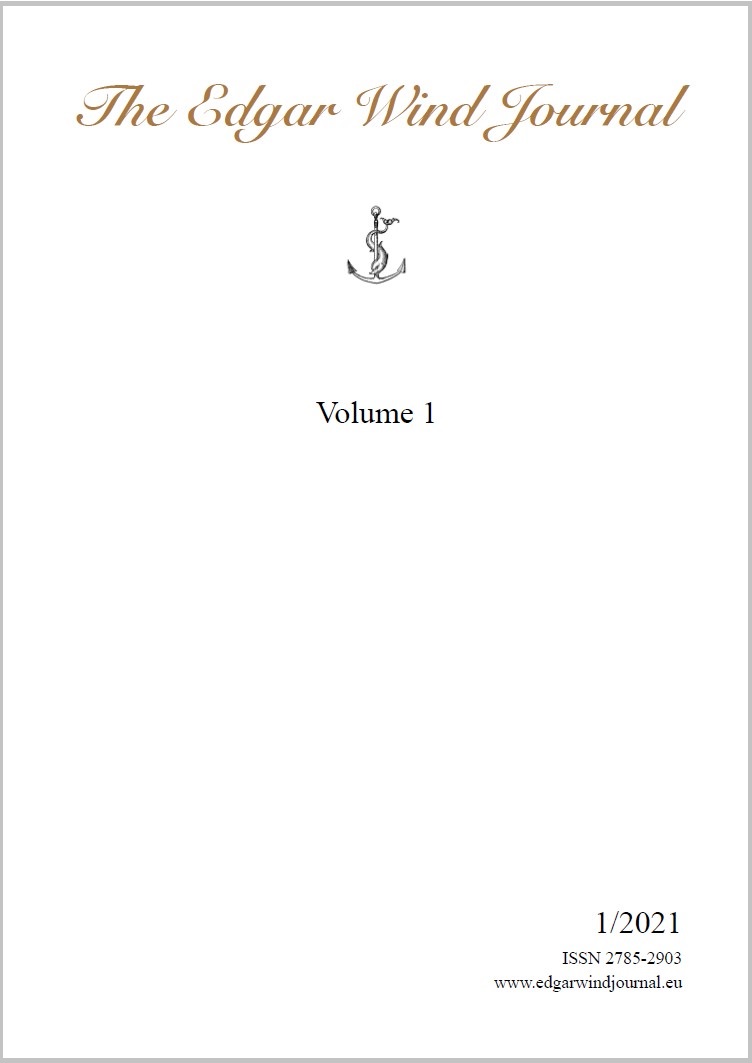Guido Boffi Università Cattolica del Sacro Cuore di Milano

Abstract
These days, forms of artistic products mostly belong to the universe of the generalized visual
regime. Can we mean the same thing when we apply the expression ‘form of the artwork’ to the
products of our time as well as to the works described by Wind and especially by Warburg? In
other words: what is the issue of the artwork’s form? I maintain that the compelling nature of the
question of form may well emerge in the light of the writings of Wind and Warburg. For both, the
artwork reveals itself as the connection along time between the deep background (mythicalenergetic), and its phenomenality, in which it materializes but can never be exhausted. In this sense,
the form is the differential between being and a configuring, expressive force. Warburg’s research
moves from a primitive (prelinguistic) background to its redefinition in panels and linkages of
meaning (the Bilderatlas); Wind goes the opposite way: from Panofsky-like schematism to empirics
and historicity.
Keywords
Artwork; Form; Historicity; Myth; Time
Bibliography
Adorno, Theodor W., Minima Moralia: Reflections on a damaged Life, trans. by Edmund F.N. Jephcott (London and New York: Verso, 2005).
Bing, Gertrud, Aby M. Warburg. Vortrag anlässlich der feierlichen Aufstellung von Aby Warburgs Büste in der Hamburger Kunsthalle am 31. Oktober 1958 (Hamburg: [n. pub.], 1958).
Boffi, Guido, ‘Immagini della memoria. Warburg e Benjamin’, in Rivista di Filosofia neo-scolastica, 3 (1986), 432-448.
Branca, Bernardino, Edgar Wind filosofo delle immagini. La biografia intellettuale di un discepolo di Aby Warburg (Milan and Udine: Mimesis, 2019).
Centanni, Monica, ‘L’originale assente’, in L’originale assente. Introduzione allo studio della tradizione classica, ed. by Monica Centanni (Milan: Bruno Mondadori, 2005), pp. 3-41.
Forster, Kurt W. and Katia Mazzucco, Introduzione ad Aby Warburg e all’ ‘Atlante della Memoria’, ed. by Monica Centanni (Milan: Bruno Mondadori, 2002).
Ghelardi, Maurizio, ‘Magia bianca. Aby Warburg e l’astrologia: un “impulso selvaggio della scienza”’, in A. Warburg, Astrologica. Saggi e appunti 1908-1929, ed. by M. Ghelardi (Turin: Einaudi, 2019), pp. 7-70.
——, Aby Warburg. La lotta per lo stile (Turin: Aragno, 2012).
Panofsky, Erwin, ‘Ueber das Verhältnis der Kunstgeschichte zur Kunsttheorie. Ein Beitrag zu der Erörterung über die Möglichkeit “kunstwissenschaftlicher Grundbegriffe”’, in Zeitschrift für Ästhetik und allgemeine Kunstwissenschaft, 2 (1925), 129-161.
Rowley, Neville and Jörg Völlnagel, eds., Zwischen Kosmos und Pathos. Berliner Werke aus Aby Warburgs Bilderatlas ‘Mnemosyne’ / Between Cosmos and Pathos: Berlin Works from Aby Warburg’s ‘Mnemosyne’ Atlas (Berlin: Deutscher Kunstverlag, 2020).
Settis, Salvatore, The future of the ‘Classical’, trans. by Allan Cameron (Cambridge and Malden, MA: Polity Press, 2006).
——, Incursioni. Arte contemporanea e tradizione (Milan: Feltrinelli, 2020).
Tack, Laura, The Fortune of Gertrud Bing (1892-1964): A Fragmented Memoir of a Phantomlike Muse (Leuven: Peters, 2020).
Thomas, Ben, ‘Edgar Wind. A Short Biography’, in Stan Rzeczy, 8 (2015), 117-137.
——, Edgar Wind and Modern Art: In Defence of Marginal Anarchy (London: Bloomsbury Publishing, 2020).
Warburg, Aby, Werke in einem Band, ed. by M. Treml, S. Weigel and P. Ladwig, in co-operation with S. Hetzer, H. Kopp-Oberstebrink and C. Oberstebrink (Berlin: Suhrkamp, 2018).
——, Bilderatlas ‘Mnemosyne’: The Original, ed. by R. Ohrt and A. Heil, in cooperation with Haus der Kulturen der Welt/The Warburg Institute (Berlin: Hatje Cantz, 2020).
Wind, Edgar, ‘Zur Systematik der künstlerischen Probleme’, in Zeitschrift für Ästhetik und allgemeine Kunstwissenschaft, ed. by Max Dessoir, 4 (1925), 438-486.
——, ‘The Eloquence of Symbols’, in The Burlington Magazine, 573 (1950), 438-486.
——, Art and Anarchy, 3rd edn, (London and Evanston: Northwestern University Press, 1985).
——, ‘Θεῖος Φόβος (Laws, II, 671D): On Plato’s Philosophy of Art’, in The Eloquence of Symbols: Studies in Humanist Art, ed. by J. Anderson (Oxford: The Clarendon Press, 1983), pp. 1-19.
La Rivista di Engramma, ed. by Monica Centanni, <www.engramma.it> [accessed 13 September 2021].
The Edgar Wind Journal 1: 39-54, 2021
DOI: 10.53245/EWJ-00003
Copyright: © 2021 G. Boffi. This is an open access, peer-reviewed article published by Bernardino Branca